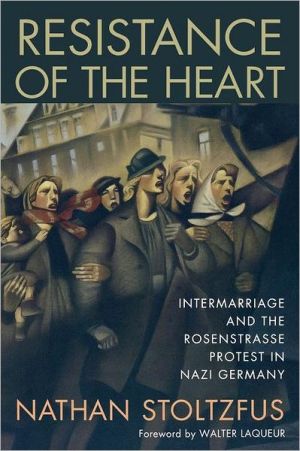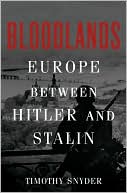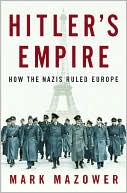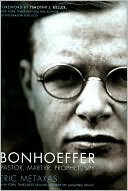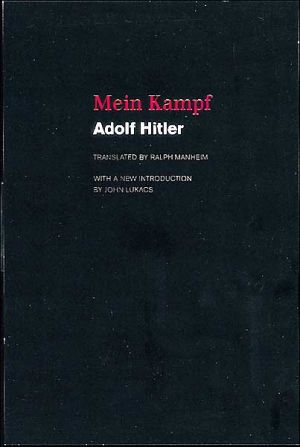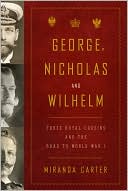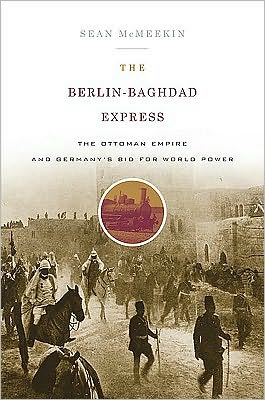Resistance of the Heart: Intermarriage and the Rosenstrasse Protest in Nazi Germany
"The Rosenstrasse protest . . . shows that a great number, probably a great majority . . . of the Aryan partners in mixed marriages did not forsake their Jewish spouses, despite often overwhelming pressures to do so. . . . What happened in this small and ordinary Berlin street was an extraordinary manifestation of courage at a time when such courage was often sadly absent."-from the foreword by Walter Laqueur\ "Goldhagen's Hitler's Willing Executioners created a furor with his sweeping and...
Search in google:
In February 1943, the Nazis began a final roundup of German Jews. The Gestapo swiftly arrested approximately 10,000 Jews remaining in Berlin. Most of them died within days in the gas chambers of Auschwitz. Two thousand of those Jews, however, were locked into a temporary collection center on a street called Rosenstrasse, in the heart of Berlin. These two thousand had non-Jewish, German husbands, wives, and children. As news of the huge arrest spread throughout the city, hundreds of Gentile spouses, mostly women, hurried to the Rosenstrasse in protest. A chant broke out, "Give us back our husbands." The protest lasted a week. Repeatedly, the Berlin police and uniformed SS scattered the women with threats to shoot them down. Again and again, the women regrouped and advanced in solidarity until the Gestapo backed down and freed their loved ones. Who were these intermarried Germans who dared to disobey history's most ruthless regime? Why did they choose to suffer the stigmas of intermarriage? What motivated them to risk their lives? And why did Hitler and Goebbels give in to the protesters and release two thousand Jews? If more Germans had protested, might the Holocaust have been slowed or even stopped? Resistance of the Heart is a powerful response to these questions and events. While charting the lives of intermarried couples in the context of Nazi persecution and social harassment, the history of the Rosenstrasse protest demonstrates the courage - and compromise - of self-protective resistance. Using interviews with survivors and thousands of Nazi records never before examined in detail, Nathan Stoltzfus has reconstructed a precise, intelligent, and inspiring story. Publishers Weekly In early 1943, the Gestapo rounded up most of the Jews remaining in Berlin, the majority of whom were married to German gentiles, and interred them in a facility on Rosenstrasse, a street in the heart of the city. In the following days, their non-Jewish spouses congregated spontaneously on Rosenstrasse and demanded the return of their mates. Despite threats from the SS to shoot anyone gathering around the building, the spouses held their ground, and eventually Joseph Goebbels agreed to release the 1700 intermarried Jews. Stoltzfus, who teaches history at Florida State University, has written a powerful, exhaustively researched report on that rare episode of open, successful resistance to the regime and reaches a telling conclusion: the Nazi state was so concerned with popular acceptance that public protest could have stopped many of its murderous policies. For a significant example, he cites the Catholic Church's successful opposition to the Nazi's euthanasia program: "[I]t seems beyond any doubt that if the churches had opposed the killing... of the Jews as they opposed the killing of the congenitally insane and sick, there would have been no Final Solution." Interwoven here are the poignant, compelling histories of couples from mixed marriages who opposed the Nazisand survived the regime. (Nov.)
AcknowledgmentsIntroductionIHitler's Theory of Power3IIStories of Jewish-German Courtship17IIIThe Politics of Race, Sex, and Marriage41IVCourage and Intermarriage50VMischlinge: "A Particularly Unpleasant Occurrence"57VISociety versus Law: German-Jewish Families and Social Restraints on Hitler65VIISociety and Law: German-Jewish Families and German Collaboration with Hitler76VIIIKristallnacht: Intermarriages and the Lessons of Pogrom98IXAt War and at Home: Mischlinge in Hitler's Army112XRacial Hygiene, Catholic Protest, and Noncompliance, 1939-41124XIThe Star of David Decree: The Official Story and the Intermarried Experience150XIIThe Price of Compliance and the Destruction of Jews162XIIIPlans to Clear the Reich of Jews - and the Obstacles of Women and "Total War"192XIVCourageous Women of Rosenstrasse209XVProtest, Rescue, and Resistance258Epilogue279Notes on Sources and Discovery289Endnotes299Bibliography355Index365
\ Publishers Weekly - Publisher's Weekly\ In early 1943, the Gestapo rounded up most of the Jews remaining in Berlin, the majority of whom were married to German gentiles, and interred them in a facility on Rosenstrasse, a street in the heart of the city. In the following days, their non-Jewish spouses congregated spontaneously on Rosenstrasse and demanded the return of their mates. Despite threats from the SS to shoot anyone gathering around the building, the spouses held their ground, and eventually Joseph Goebbels agreed to release the 1700 intermarried Jews. Stoltzfus, who teaches history at Florida State University, has written a powerful, exhaustively researched report on that rare episode of open, successful resistance to the regime and reaches a telling conclusion: the Nazi state was so concerned with popular acceptance that public protest could have stopped many of its murderous policies. For a significant example, he cites the Catholic Church's successful opposition to the Nazi's euthanasia program: "[I]t seems beyond any doubt that if the churches had opposed the killing... of the Jews as they opposed the killing of the congenitally insane and sick, there would have been no Final Solution." Interwoven here are the poignant, compelling histories of couples from mixed marriages who opposed the Nazisand survived the regime. (Nov.)\ \ \ \ \ Library JournalStoltzfus (history, Florida State Univ.) has written about an unusual and striking episode of the Holocaust. In February 1943, the remaining 10,000 Jews of Berlin were rounded up by the Gestapo; of these, about 2000 were married to non-Jews. These 2000 were herded to a collection center on the Rosenstrasse, the street that was a former center of Jewish life. Word spread quickly among the Christian spouses and relatives, and a public protest ensued, lasting a week. The author's work is groundbreaking in documenting the sensitivity of the Hitler regime to public opinion. After initial vacillation, a decision was made to release the prisoners. Stoltzfus has done an impressive job of presenting this unusual episode. He emphasizes that if the church had protested against the treatment of the Jews as it did, successfully, against the euthanasia program, the Holocaust would not have occurred. He examines issues pertaining to, among other things, intermarriage between gentile and Jewish Germans and adds an extra dimension to his account with poignant, compelling interviews with survivors, which provide the backbone of the book and make it very readable for generalists. Highly recommended for large public and academic libraries.Paul Kaplan, Lake Villa Dist. Lib., Ill.\ \ \ Stoltzfus's (history, Florida State U.) 1996 book has now appeared in paper. The Rosenstrasse protest consisted almost entirely of women protesting the arrest of their Jewish husbands by the Nazis in 1943. The Nazis, surprisingly enough, gave in, and almost all of the men survived the war in their Berlin neighborhood. Using interviews with survivors and other primary resources, Stoltzfuz reconstructs the story, offering his analysis of how intermarriage with Germans was viewed by the Gestapo and by Hitler. Annotation c. Book News, Inc., Portland, OR (booknews.com)\ \
